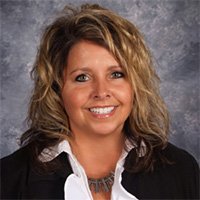As an associate principal, I find my days filled with constant interactions with students, teachers, and support staff involving day-to-day operational needs, making decisions that affect everyone, acting as a sounding board, listening to various problems, observing and evaluating teachers, helping students and teachers reach their full potential, and doing things that impact our school culture. In my spare time, I am reading and responding to emails and making phone calls. Every day, I start my day hoping to make a difference or just make that one connection that may make someone smile. I enjoy walking the halls and hanging out in the cafeteria with students, checking in on them and wishing them a great day! Most students are used to the routine, so it becomes a race as to who wishes who a good day first.
With all these responsibilities and more on our plates, it can be hard to find time to reflect on our “why”—our purpose. As we celebrate National Assistant Principals Week, let’s reflect on a few things that drive our purpose.
- Fostering and Building Effective Relationships
- Building a Positive School Culture
- Collaborative Leadership
- Personal Development and Leadership Growth
In my opinion, our role is one of the most important jobs in our organization besides our teachers—every day we get to come to work and make a difference in the lives of students and staff we serve, leaving an impact on the culture of the school.
1. Fostering and Building Effective Relationships
How do you build relationships and connect with your students and staff?

Building trust matters. I like to be present and visible in the hallways, classrooms, and lunchroom. Every year I meet and greet the incoming freshmen during the school year to learn about their interests and share a little about myself. It is a very informal meeting of six students, during which we laugh and learn together about each other. Students leave meeting new friends, and I leave learning which students I can support in various clubs and extracurricular activities outside of the school day, as well as which students I need to engage with more to build their connectedness to our school. Being visible in the hallways, classrooms, and lunchroom pays it forward when you need to address an arising matter. Learning about your students and teachers and their lives outside of school allows for a deeper connection—and one that supports student achievement.
2. Building a Positive School Culture and Climate
How do you motivate and encourage your students and staff?
Building and providing a positive school culture where students and teachers want to do their best and perform to the best of their ability is essential to our success. Marcus Buckingham encourages you to look at everyone’s strengths and develop them. In a recent tweet, he stated, “Positive attention is 30 times more powerful than negative attention in creating a high-performing team.”
This tweet resonated with me greatly, for when I was a teacher the only way I could get my struggling learners to be productive was to connect with them and help them along. The same goes for my current position as an associate principal, where research and practice have shown that creating a collaborative culture of learning is one of the most important components of school leadership, as seen in this video from PBS and the Wallace Foundation.
I have learned to feed teachers through our positive school culture to impact and influence their performance. I find meeting students and teachers where they are provides an in-depth opportunity to build each individual’s capacity by understanding their strengths and learning together in a collaborative manner of support. Having fun at work is a must! Recognize your staff often and praise their efforts, for they are the reason for our success.
3. Collaborative Leadership
How do you lead learning and foster a collaborative learning environment?
Creating and supporting a collaborative culture should be a deliberate and intentional act of bringing your teachers, students, and district stakeholders together to learn, make decisions, and work toward a common goal and shared vision. This, I believe, is the “how” behind the work of our great staff and the ‘why’ behind our high-performing school district.
By providing the time to work together, our teachers find creative ways to work with our students, help them learn, and improve student achievement. Teachers have built fun-loving relationships with one another and support each other in their work. I have noticed a high level of energy and creativity and have observed teacher growth as the result of creating a collaborative learning environment. Leading and learning in this environment to discuss our work and collaborate on arising problems, sharing ideas, and taking responsibility for our students’ achievement and development growth is instructional leadership and where the synergy occurs.
4. Personal Development and Leadership Growth
How do you continue to grow as a leader?
We all possess and understand the skills that make us good at what we do, including but not limited to being present and visible with our students, staff, and school community; building a strong school culture; fostering collaboration; providing opportunities for students’ voices to be heard; and leading intentionally with our values. But what you are doing to continue your personal development and growth?
I find myself thirsty for learning with other professionals; joining and leading Twitter chats; attending conferences and webinars; being active members of our state and national principal organizations; serving on the Principal’s Center at Cardinal Stritch University, where I collaborate with an efficient team with a shared vision to develop professional development opportunities for other local administrators; and reading the latest articles in hope of encouraging, inspiring, and motivating those I serve to take risks, be creative, and create change that will help shape the future of our school.
Regardless of how you enter your next school year, enter it with intention and grit. Your leadership and visibility to your students and staff will set the daily tone in your building for either thriving or surviving. We serve in administrative positions, and the right leadership will foster a positive school culture and motivate your students and teachers to take risks and reach their full potential.
Your days may be filled with a feeling of accomplishment or, at times, dissatisfaction based on the various tasks you encounter wearing the many hats we do in our role. By using our skillful management skills and knowledge of education and leadership, we have undeniable opportunities to influence student achievement and culture within our buildings. Every day won’t go as planned, so grant yourself some grace.
Wherever your journey takes you, continue to influence others and make a difference in the lives of others. Intentionally follow your values and lead with integrity. Find your passion, your why, and believe you are enough for your students and staff. They are waiting and deserve your very best.


1 Comment
This article is so every day. Thank you for being open.